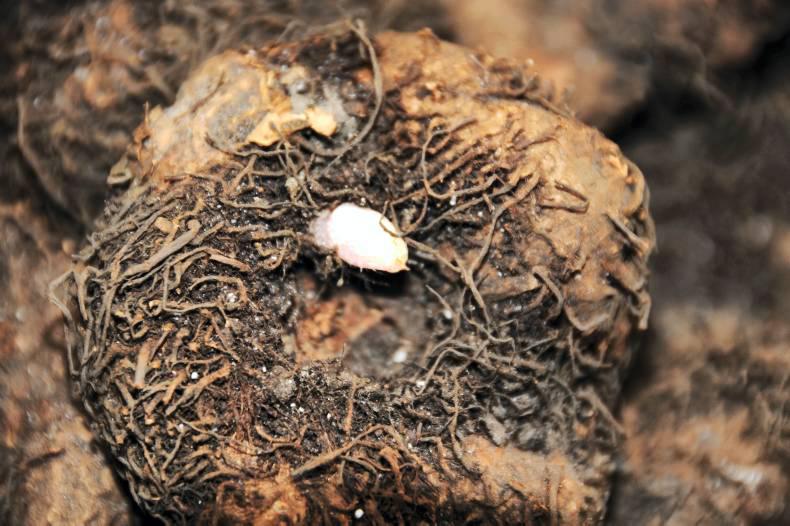Not a true cherry, the cornelian cherry, or cornel, is actually related to the red-barked dogwood that is seen as a native shrub by waterways and, increasingly with some related dogwoods, by motorways. Unlike its relatives, the cornel does not have coloured bark at all – more of a light grey colour that suits its yellow flowers nicely.
This bushy shrub has very pretty starry yellow flowers in clusters along bare branches in late winter and early spring. The individual flowers are very small but the clusters are noticeable. Luckily, the flowers appear before the leaves because they would be hidden otherwise.
By being visible early in the year, they can be pollinated by early-flying insects such as bumblebees. The colour of the flowers is a distinctive acid-yellow, a bright colour to be noticed by passing pollinators.
The plant forms a big bush and might be too big for most gardens, as it can reach three or even four metres eventually. A big garden would be able to accommodate a bush of this size but it might squeeze out other plants in a smaller space. It would be fine for a rural garden where space is not as much of an issue. Also, it is a very natural-looking plant, as it is the original unaltered species, and would not clash with the surrounding countryside.
Alternatively, it could be treated as a small tree where space is at a premium. It takes pruning very well and the lower branches can be pruned out as the small tree grows, creating space for shade-tolerant plants, such as hellebores and epimediums, and spring bulbs to grow comfortably beneath. The combination of spring flowers on these plants with the yellow flowers of cornel is very appealing.
It is not native to Ireland but is native to eastern areas of Europe and western Asia and, coming from such places which have a very cold winter, it is more than able to deal with any frost it is likely to get in this country. It produces one of the most dense timbers, so much so that it does not float.
Because of this hardness, it was widely used in ancient times for making spears and tool handles.
The tree is also valued for its edible bright red fruits that follow the yellow flowers, ripening in summer. Though edible, the slightly elongated, cherry-like fruit is sharply acidic and astringent, and ripens fully only when it falls from the bush or is picked a while. It was used traditionally in a variety of ways, including flavouring spirits.
Unattractive
When not in flower, the cornel is not the most attractive shrub, as it tends to be rather shapeless, and the foliage is not special. But a bush could be located towards the back of a border with other shrubs, giving its flowers in season and then providing backdrop for colourful smaller flowering plants. Like most dogwoods, the cornelian cherry foliage slowly changes colour to good shades of red and purple in autumn, being best expressed in a sunny autumn.
There are several variegated forms that are sometimes planted, but the effect of the variegation is to make the bush look diseased in summer. The variegated plants are less vigorous than the plain green kind and do not flower as well. The ordinary cornel is a robust plant and grows in any ordinary soil that is reasonably well drained. CL
Start begonia tubers now
Tuberous begonias are one of the most colourful summer garden flowers. From a tuber planted in March, it easily makes a 40cm tall plant by July, carrying masses of saucer-sized, brightly coloured flowers. It can be started off indoors in spring, by inserting the tubers to their depth in damp compost. Water very little until there is active new growth, then grow on well, potting up as necessary and feeding to get a good-sized plant. The potted plants can be kept in a greenhouse where they luxuriate or they can be planted into outdoor containers, or flower beds, when they have been carefully hardened off at the end of May or early June. It is well worth the small effort and expense.
Trees, shrubs and roses
Bush roses and repeat-flowering climbers should be sprayed against blackspot disease. Pruning should be finished, but should still be done if not. Finish any planting of bare-root plants, or moving of shrubs. Check all young trees and shrubs planted to ensure that they are being wind-rocked.
Flowers
Sow seeds of marigolds, petunias and dahlias in a warm place or a propagator, otherwise wait and buy plants in May. Lifting and dividing of herbaceous flowers should be completed by now as they are in growth but can be carried out, as long as the plants are watered until they re-establish fully.
Fruit, vegetables and herbs
Fruit trees and bushes can still be planted but as soon as possible now. Pruning of apple and pear trees and blackcurrant bushes should be completed. Most vegetables are heavy feeders and compost or manure or compound fertiliser should be applied before sowing.
Lawns
There has been a lot of wet weather and little chance to use the lawnmower. Mowing should have been carried out already or at the first opportunity. Existing lawns can be oversown if there are bare patches. Use lawn moss killer if there is heavy moss growth. It is too soon to feed a lawn.
Greenhouse and house plants
Start off begonias right away for summer flowers. Check for greenhouse pests and spray if necessary. Feed and water all greenhouse plants regularly to keep them growing. Sow seeds of tomatoes for greenhouse growing, without delay, as well as sweet peppers and chilli peppers.






SHARING OPTIONS